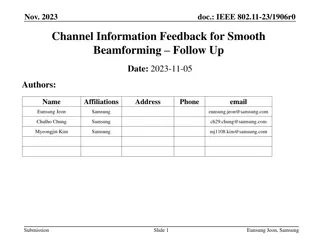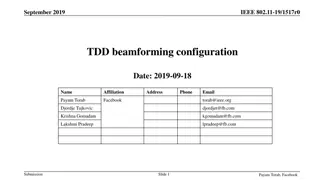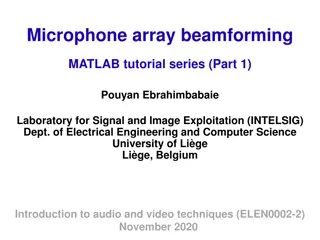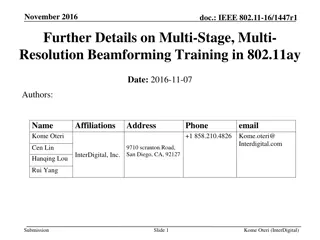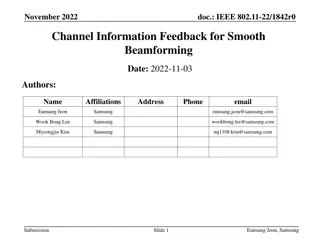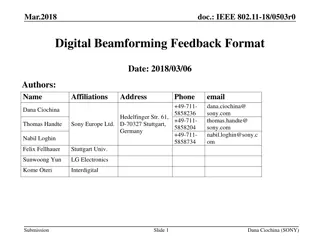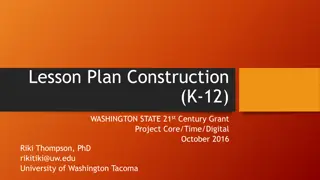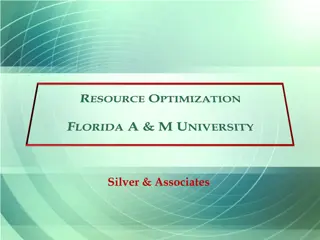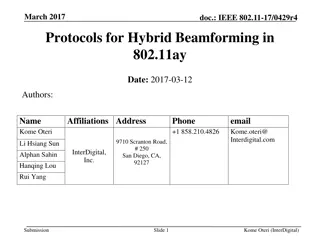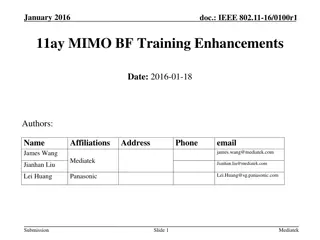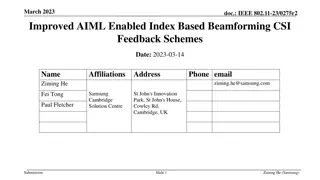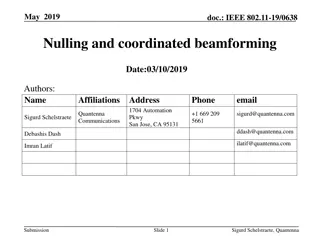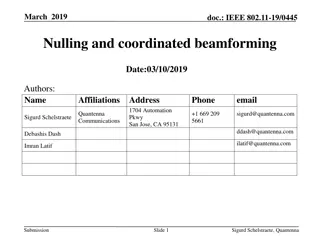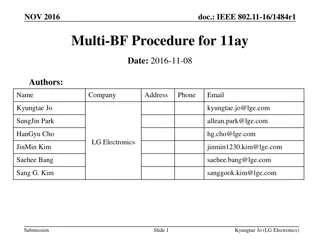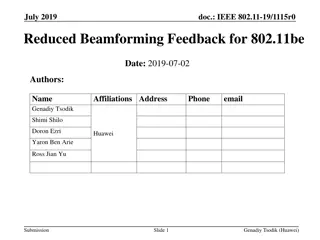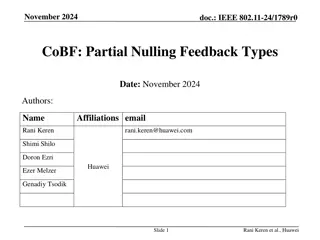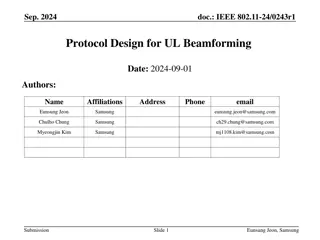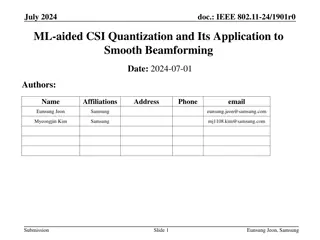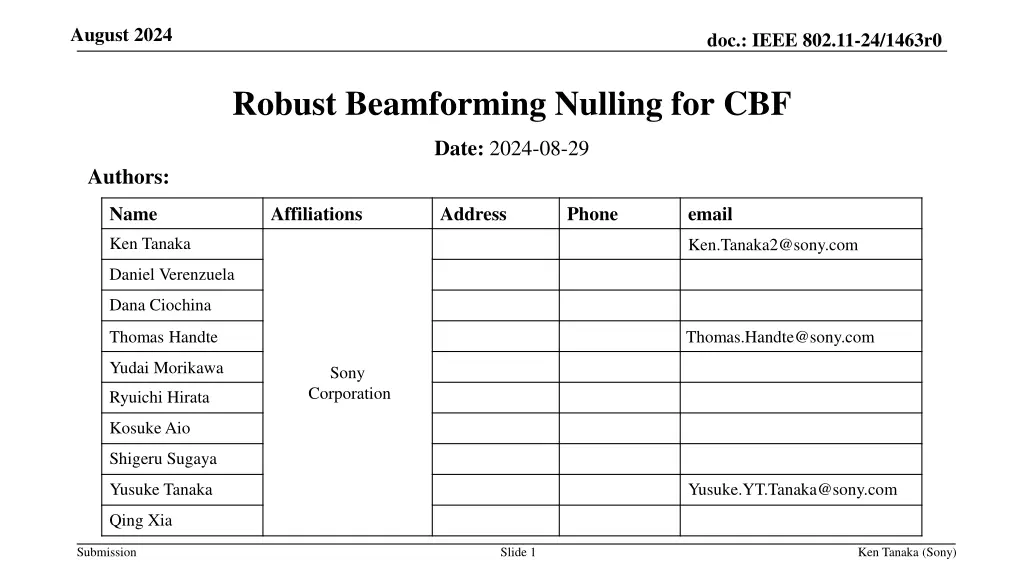
Robust Beamforming Nulling for CBF in IEEE 802.11-24
Explore the advancements in beamforming nulling technology for enhancing reliability and reducing interference in high-throughput applications. The research delves into the design of transmission and receive nulling, coordination procedures, and channel fluctuation evaluations to improve robustness. Simulation scenarios and evaluation metrics provide insights into the performance of beamforming nulling schemes under various scenarios.
Download Presentation

Please find below an Image/Link to download the presentation.
The content on the website is provided AS IS for your information and personal use only. It may not be sold, licensed, or shared on other websites without obtaining consent from the author. If you encounter any issues during the download, it is possible that the publisher has removed the file from their server.
You are allowed to download the files provided on this website for personal or commercial use, subject to the condition that they are used lawfully. All files are the property of their respective owners.
The content on the website is provided AS IS for your information and personal use only. It may not be sold, licensed, or shared on other websites without obtaining consent from the author.
E N D
Presentation Transcript
August 2024 doc.: IEEE 802.11-24/1463r0 Robust Beamforming Nulling for CBF Date: 2024-08-29 Authors: Name Affiliations Address Phone email Ken Tanaka Ken.Tanaka2@sony.com Daniel Verenzuela Dana Ciochina Thomas Handte Thomas.Handte@sony.com Yudai Morikawa Sony Corporation Ryuichi Hirata Kosuke Aio Shigeru Sugaya Yusuke Tanaka Yusuke.YT.Tanaka@sony.com Qing Xia Submission Slide 1 Ken Tanaka (Sony)
doc.: IEEE 802.11-24/1463r0 August 2024 Introduction (1/2) Concurrent Transmission from multiple APs has been discussed It is envisioned to enhance reliability by suppressing interference Coordinated beamforming nulling is beneficial for high throughput & reliability applications such as VR Beamforming nulling is an essential feature, and the following has been discussed [1-3] 1) Tx Nulling (CBF) design of a precoder such that mutual interference is reduced 2) Rx Nulling design of MIMO equalizer to reduce interference Current situation [4-11] General M-AP coordination procedure is being discussed Synchronization aspects are investigated to ensure low interference LTF design is studied to improve MMSE receive performance Submission Slide 2 Ken Tanaka (Sony)
doc.: IEEE 802.11-24/1463r0 August 2024 Introduction (2/2) In beamforming nulling, the steered null is fragile against time-varying channel Generally, a steered null is sharper than the main lobe, and multi-user interference (MUI) is increasing as time advances Frequent sounding would be helpful, but reduces goodput In this contribution, 1) we evaluate fluctuation of nulling under time-varying channel - to observe how interference is increasing after channel sounding 2) we suggest a precoding scheme for improving robustness of nulling, and evaluate its performance Submission Slide 3 Ken Tanaka (Sony)
doc.: IEEE 802.11-24/1463r0 August 2024 Simulation Scenario (4x1 steering vector) (4x1 steering vector) ?? ?? ?? STA2 (Steered null from AP1) ?? AP1 AP2 *Not implemented in simulation STA1 (Intended Receiver of AP1) Configuration Channel Model D-NLOS @ 5GHz Doppler Frequency (??) : 5.5Hz AP: 4 antennas, 1 spatial stream, STA: 1 antenna Evaluation Metrics Intended Signal Level: ????, Interference Level: ???? Submission Slide 4 Ken Tanaka (Sony)
doc.: IEEE 802.11-24/1463r0 August 2024 Simulation Assumption CSI Feedback Non-AP STA (beamformee) obtains perfect CSI Compressed beamforming feedback (FBCK)I with ??,?? = 7,9 . First FBCK is obtained at ? = 0 [ms] Sounding and CSI FBCK are performed every 12 ms Sounding and FBCK overhead are assumed to be zero. Precoding 1?? ???+ ??? ??? SLNR-based precoding [14]: ?1= ??? ?? ?1,2: 1-by-4 vector, ??: White Gaussian Noise level Submission Slide 5 Ken Tanaka (Sony)
doc.: IEEE 802.11-24/1463r0 August 2024 Simulation Results (1/2) (4x1 vector) ?1 ?? STA2 (Steered null) 10dB ?? AP1 STA1 (Intended Receiver) Simulation result shows |?1?1| and |?2?1| over time for a particular subcarrier SIR is degrading over time until a new CSI FBCK is obtained Just before a new CSI FBCK is obtained, SIR is about 10dB (green arrow in the figure). For higher data rate & higher reliability, more interference reduction would be needed Submission Slide 6 Ken Tanaka (Sony)
doc.: IEEE 802.11-24/1463r0 August 2024 Simulation Results (2/2) 10dB 19 Interference levels on all subcarriers increase after steering matrices are updated. Submission Slide 7 Ken Tanaka (Sony)
doc.: IEEE 802.11-24/1463r0 August 2024 Observation To reduce interference impact in CBF, the following approaches can be envisioned More frequent sounding Frequent sounding/Feedback overhead degrades goodput Steering broad/robust null Steering matrices are designed to be long-term stable nulling Allocating parts of spatial degree of freedoms (DoFs) to nulling improve robustness of nulling [22/1649][12]proposes to allocate either extra or more but not both spatial DoFs for nulling to interferer Beamforming AP (Bfer) can allocate more extra spatial DoFs for nulling to unintended receiver. For nulling enhancement, we consider an approach, where the computation of beamforming nulling considers not only the current CSI but also past CSI towards the unintended receiver (?2) [15] Submission Slide 8 Ken Tanaka (Sony)
doc.: IEEE 802.11-24/1463r0 August 2024 Candidate Nulling enhancement: Null Space Expansion[15] ?2? + ? is almost in the same plane with past CSI vectors ??(?)?? ?2? ?2? ? ?? ?2? 2 ? ? Improving beamforming by enlarging null space of Bfer by levraging past CSIs of unintended receiver - ?2(?) is most likely to be in the same space containing two past CSI vectors, ?2(? ?) and ?2(? 2 ?), and just steering null to ?2? ? and ?2(? 2 ?) would be most likely to steer null to ?2? Compressed Beamforming FBCK can be still used for precoding Submission Slide 9 Ken Tanaka (Sony)
doc.: IEEE 802.11-24/1463r0 August 2024 Evaluation of Null Space Expansion (4x1 steering vector) (4x1 steering vector) ?? ?? ?? STA2 (Steered null from AP1) ?? AP1 AP2 *Not implemented in simulation STA1 (Intended Receiver of AP1) Precoding 1) SLNR-based BF [14] (Baseline): 1 ?1 ??1 ?1?1 ?2 ??1 ?2?1 + ??? ? = ??? 2) SLNR-based BF using two CSIs (Null Space Expansion [15]) ?2?1 ?2?2 1 ?1 ??1 ?1?1 ?2 ??1,?2 ?2?1,?2 + ??? ,where ?2?1,?2 = ? = ??? ?? ???: Compressed Beamforming FBCK of ??obtained at ? = ?? Submission Slide 10 Ken Tanaka (Sony)
doc.: IEEE 802.11-24/1463r0 August 2024 Simulation results (1/2) (4x1 steering vector) ?1 ?? STA2 (Steered null) ?? AP1 STA1 (Intended Receiver) NSE is active 20dB Null Space Expansion is active after two CSIs have been obtained. (? = 12 ms ) Intended signal level degrades by approx. 3dB compared to baseline Interference reduced by 11.5 dB in average compared to baseline Just before a new CSI FBCK is obtained, SIR is about 20dB 12 Submission Slide 11 Ken Tanaka (Sony)
doc.: IEEE 802.11-24/1463r0 August 2024 Simulation results (2/2) NSE is active after 12ms NSE isn t active 19 NSE is active (Two CSIs are obtained) Submission Slide 12 Ken Tanaka (Sony)
doc.: IEEE 802.11-24/1463r0 August 2024 Conclusion and Thoughts We evaluate Tx nulling enhancement candidate under time-varying channel Interference level can be reduced by approx. 10dB by leveraging past CSI values Further enhancement of robust beamforming nulling is feasible by More transmit antennas at AP [23/1998r0][16]proposes feedback left singular vector, and achieve to maintain zero MUI under more Rx antenna situation [22/1649] [12]proposes interference suppression at receivers. Combination can reduce number of Tx antenna requirements. Precoding/ feedback scheme for CBF would need to be revised such that robust beamforming nulling can be implemented, e.g., feedback scheme such that a non-AP STA can indicate to the AP, which CSI values have better correlation with current CSI Submission Slide 13 Ken Tanaka (Sony)
doc.: IEEE 802.11-24/1463r0 August 2024 References [1] 22/1821r1, System Level Simulation of Co-BF and Joint Tx [2] 19/1212r2, Performance of Coordinated Null Steering in 802.11be [3] 24/0012r0, Coordinated Spatial Nulling (C-SN) Simulations [4] 23/1868r2, Coordinated Spatial Reuse Design [5] 22/1895r0, Thoughts on M-AP Coordination Principles [6] 22/1899r0, Multi-AP Operation for Low Latency Traffic Delivery Follow up [7] 23/1871r2, M-AP Coordinated Transmission frame work [8] 24/0072r0, MAP channel access procedure [9] 24/0011r0, Coordinated Spatial Nulling (C-SN) Concept [10] 19/0445, Nulling and coordinated beamforming [11] 23/1193, Nulling Performance of Coordinated Beamforming [12] 22/1649, MIMO Interference Suppression for enhanced reliability [13] 24/0156r0, Minutes 802.11bn PHY ad hoc Jan Interim meetings [14] Mirette Sadek, et al., A Leakage-Based Precoding Scheme for Downlink Multi-User MIMO Channels, IEEE Trans. on Wireless Commun., May 2007 [15] Tatsuhiko Iwakuni, et al., Inter-user interference suppression in time varying channel with null-space expansion for multiuser massive MIMO, 2015 IEEE PIMRC, Aug. 2015 [16] 23/1998r0, Zero-MUI Coordinated Beamforming Submission Slide 14 Ken Tanaka (Sony)


